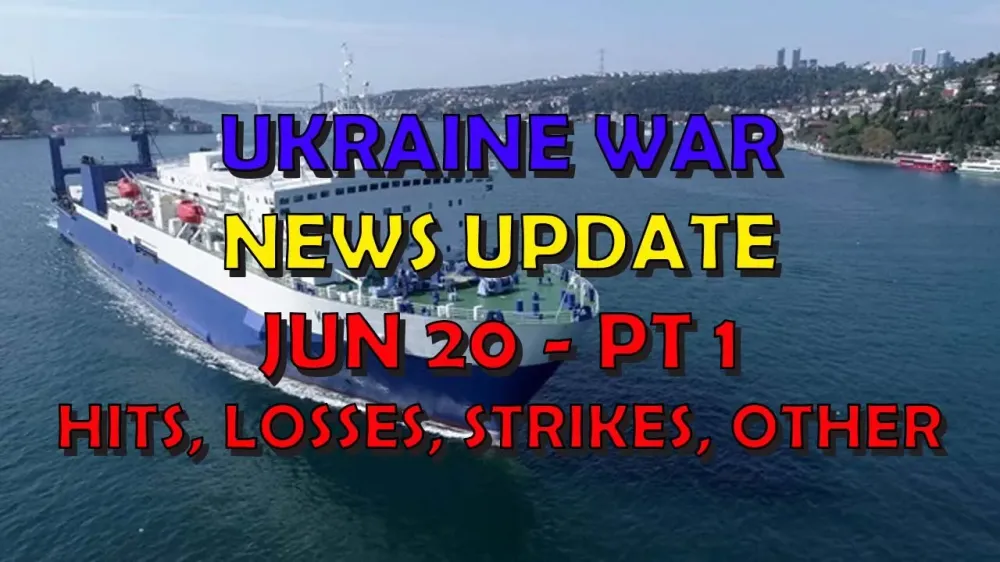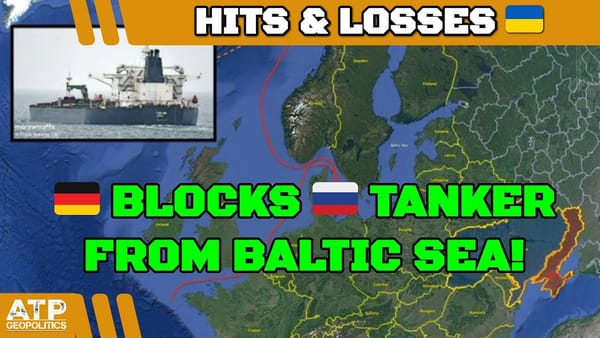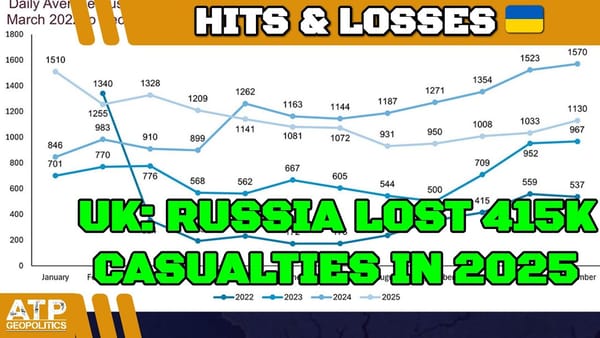Ukraine War Update NEWS: Pt 1 - Overnight & Other News
🤖
This summary has been produced automatically by an AI Large Language Model (LLM) without any human intervention. Whilst every effort has been made to prompt the LLM to produce accurate output, there may be inconsistencies, inaccuracies or hallucinations!
Table of Contents 📖
| Topic ID | Topic Title | Timestamp |
|---|
"They are unable to repair schools in Irkutsk because that money needs to go to the war effort. That's what unsustainable losses look like."
Hello Team🎦 00:00-00:12⏩
Jonathan welcomes viewers to a Ukraine War Update News for the 20th June 2024 and refers to the Ukrainian General Staff figures which will follow.
Return to top⤴️
🪦 DISCLAIMER FOR GENERAL STAFF LOSSES DATA
- These are real people with real lives and real families who love them. Don’t let the numbers sap your humanity.
- These numbers probably aren’t accurate but they’re the best we have and we don’t need them to be accurate to be indicative of patterns of activity.
- All losses are estimates. Losses cannot be counted with accuracy because of the conditions on the ground.
- Both sides would see it to be of their advantage to minimize their own losses maximize the other side’s losses.
- Neither side releases their losses but we have enough transparency from the Ukrainian side to have confidence in they are indicative.
- Personnel losses are hard to count. If a soldier gets injured, heals up, and returns to the front line only to get injured again, is that one loss or two? Also, how to deal with losses from PMC’s or soldiers fighting with RF from occupied territories?
- Equipment losses are hard to count. If an AA complex involves several parts and one part gets disabled, is that a loss, or a fraction of a loss? If a tank gets disabled, repaired, back into the fight, then disabled again, is that one lost tank or two?
- All recorded losses are vulnerable to multiple reporting. We have already seen numerous cases of multiple drones in the air reporting the same loss from different angles as multiple engagements.
- Losses are not always reported on the same day they occurred. It is frequent that drone losses are reported at least 24 hours after other terrestrial equipment losses. Certain losses may not be reported for days or weeks for military intelligence reasons.
Ukrainian General Staff Report - Russian Losses🎦 00:12-01:13⏩
Jonathan reviews the Ukrainian General Staff's figures for Russian losses from the previous day, noting that the figures are largely consistent with those of the past month:
- 1,170 personnel.
- 3 tanks.
- 18 armoured personnel vehicles.
- 45 artillery systems (likely including heavy mortars).
- 1 multiple-launch rocket system (MLRS).
- 2 anti-aircraft warfare systems.
- 56 vehicles and fuel tanks.
- 6 pieces of special equipment.
He points out the high number of artillery and personnel losses and expresses concern about the loss of fuel tanks.
Return to top⤴️
Viewer Question: Are Russian Losses Unsustainable?🎦 01:14-11:17⏩
Jonathan addresses a viewer question about whether the high rate of Russian losses is unsustainable, a term he acknowledges he uses frequently without specific definition. He presents several data points suggesting that the losses are, in fact, impacting Russia's ability to maintain its war effort. Here are the key points:
- Reduced attack capabilities: Russia previously launched offensives with dozens of vehicles, but recent attacks often involve only a handful, suggesting limitations in their capacity to deploy large formations.
- Reconstitution and Dilution of Forces: The frequent reconstitution of units, such as the 155th Naval Infantry Brigade (nine times), highlights the strain on manpower and has led to diluted force quality.
- Use of outdated equipment: The appearance of T-55 and T-54 tanks, 70-year-old D-10, D-20, and D-30 howitzers, and a reliance on civilian vehicles (including a thousand golf carts from China!) instead of military-grade equipment reveals a depletion of modern stockpiles.
- Changes in personnel recruitment: Russia's reliance on mobilized personnel, convicts, and individuals from various backgrounds instead of primarily relying on contract soldiers, demonstrates difficulties in attracting qualified personnel.
- Redeployment from other areas: The relocation of 80% of ground forces from the Finnish border to Ukraine, along with the transfer of S-300 air defense systems from the Kuril Islands and a prototype S-500 from Moscow, signifies a need to compensate for losses in Ukraine.
- Economic and Social Impact: Russia's decision to halt school repairs in Irkutsk until 2025 to divert funds to the war effort demonstrates the strain on the Russian economy and the government's prioritization of the war over essential services.
Jonathan concludes that "unsustainable losses" don't necessarily mean a complete depletion of resources. Instead, it's reflected in the gradual degradation of equipment, manpower, and capabilities, forcing adaptation and impacting Russia's ability to wage war effectively.
Return to top⤴️
Oryx Losses 01/06/2024🎦 11:18-14:25⏩
Jonathan analyses the Oryx loss data from June 1, 2024, pointing out that Ukrainian losses are about half those of the Russians.
- Overall ratio: Russian losses are about double those of Ukraine (61 vs 33), though ideally, he notes a three-to-one ratio would be preferable.
- Combat Vehicles: The ratio is closer to parity for combat vehicles (18 Russian losses vs 12 Ukrainian).
- Ukrainian Losses: Jonathan observes an increase in Western-supplied equipment losses, but notes that most are damaged rather than destroyed, which is a positive sign. Damaged equipment can be repaired and returned to service. Ukrainian losses included Bradleys, an M113, a Kozak-7, Howitzers, an unknown tank, surveillance and communication equipment, an engineering vehicle, and an unmanned ground vehicle.
- Russian Losses: A significant proportion of Russian losses consist of civilian vehicles, ATVs, and older equipment like MTLBs, suggesting a depletion of military-grade resources. Losses included BMP-1 and BMP-2 infantry fighting vehicles, T-72B tanks, 2S1 Gvozdika self-propelled howitzers, an excavator, surveillance and communication equipment, trucks, golf carts, and quad bikes.
Jonathan reiterates his point that the types of losses suffered by both sides, especially Russia's reliance on civilian vehicles and older equipment, further underscores the unsustainable nature of the conflict for Russia.
Return to top⤴️
Russian Domestic Issues as a Result of Losses🎦 14:26-16:04⏩
Further emphasizing the unsustainable nature of Russian losses, Jonathan highlights a report from Irkutsk. The local council, following Kremlin directives to prioritize war funding, has postponed school repairs until 2025. This decision, despite the urgent need for repairs in some cases, demonstrates the economic strain caused by the war and the government's willingness to sacrifice essential social services to sustain its military campaign. Jonathan reiterates that unsustainable losses aren't solely measured by the quantity of equipment but also by their impact on various facets of Russian society and its economy.
Return to top⤴️
Ukraine's Increasing Drone Advantage🎦 16:08-17:22⏩
Jonathan discusses Ukraine's increasing drone advantage, citing anecdotal evidence from a YouTube channel called "Willie OAM" who interviewed a Ukrainian soldier. The soldier, recently returned from a six-month deployment, reported a substantial increase in Ukrainian drone activity. He was astounded by the sheer number of drones, describing it as a "steady stream," compared to just a few per day during his previous tour. While acknowledging this is anecdotal, Jonathan finds it consistent with other reports suggesting Ukraine has gained a significant advantage in drone warfare.
Return to top⤴️
Possible Ukrainian Strike - Ammunition Truck Destroyed in Luhansk🎦 17:23-18:23⏩
Jonathan presents footage of a large explosion in Pervomaisk, Luhansk Oblast, approximately 30 kilometres from the front line. Although the cause is unconfirmed, it's believed to have been a Russian ammunition truck. The truck seemingly vaporized, leaving a large crater and significant damage to the surrounding area. Jonathan speculates that a long-range drone strike could have been responsible, highlighting the increasing range and effectiveness of Ukrainian drone operations.
Return to top⤴️
Overnight Russian Missile and Drone Attacks🎦 18:23-20:10⏩
Jonathan reports on overnight Russian attacks on Ukraine involving a mix of missiles and drones. Ukrainian air defenses demonstrated a high success rate:
- Four out of four Kh-101/Kh-555 cruise missiles shot down (100%).
- 27 out of 27 Shahed drones shot down (100%).
- One out of two Kh-59 cruise missiles shot down.
- Zero out of three Iskander ballistic missiles shot down.
Jonathan notes the difficulty in intercepting ballistic missiles without systems like SAMP/T or Patriot positioned nearby. He speculates that the Iskander missiles likely targeted Dnipro. While the specific targets of the intercepted drones remain unknown, their trajectories suggest Kyiv and areas south of the capital were targeted.
Return to top⤴️
Ukrainian Drone Strikes on Russian Oil Refineries🎦 20:10-22:08⏩
In contrast to the limited confirmed damage from Russian strikes, Ukraine has reportedly conducted successful drone attacks on multiple oil refineries in Russia.
- Tambov Region: A fire broke out at an oil depot in the Tambov region, with eyewitnesses reporting a loud explosion.
- Krasnodar Region: The Afipsky oil refinery, 20 kilometers from Krasnodar, was also targeted.
- Republic of Adygea: An oil depot in Enem, a village near the Krasnodar region, was attacked. There is uncertainty about whether the depot was hit directly or if debris from a downed drone caused a fire.
Jonathan displays footage showing significant fires at two of the locations. He also mentions drone activity and possible strikes in the Lipetsk, Belgorod, Kursk, and Voronezh regions, although the outcomes in these areas remain unclear.
Return to top⤴️
Azov Oil Depot Fire Reignited🎦 22:08-23:53⏩
Jonathan reports that the fire at the Azov oil depot, previously struck by Ukrainian drones, has reignited. Russian sources confirmed the situation, stating that attempts to stabilize the depot had failed. A second tank depressurized, potentially catching fire, and firefighters struggled to contain the blaze. Jonathan highlights a comment by a Russian source who said "Kiev regime is destroying Russia's economic potential exactly" and agrees. He draws parallels to the situation in Ukraine, arguing that investing in air defense saves money in the long run as it reduces damage from attacks. Jonathan uses the example of the reconstruction conference where billions were pledged to rebuild destroyed areas, suggesting that money could have been more effectively spent on air defense beforehand.
Return to top⤴️
Possible Ukrainian Strike on Henichesk Airport🎦 23:53-24:53⏩
Jonathan shares information about possible Ukrainian strikes on Crimea. FIRMS data indicated a fire at Henichesk Airport in northern Crimea. While details are scarce, he speculates that air defense systems or radar installations, commonly found in coastal areas, might have been targeted. He mentions strong fires near Oleshky, potentially caused by explosives being dropped, and alludes to ammunition storage in the area.
Return to top⤴️
Possible Ukrainian Strike - Cape Chaldra Crimea🎦 24:53-25:36⏩
Continuing with events in Crimea, Jonathan reports explosions heard by local residents near Cape Chaldra. He notes a significant presence of ambulances, suggesting casualties. While the exact target remains unknown, he suspects it could be a military installation due to the area's proximity to the sea, making it strategically valuable for air defense and radar coverage.
Return to top⤴️
Russian Defence Minister Shoigu's Visit to the 155th Naval Infantry Brigade🎦 25:36-29:12⏩
Jonathan discusses a video showing Russian Defence Minister Shoigu visiting a military camp associated with the 155th Naval Infantry Brigade, currently undergoing reconstitution. Shoigu emphasizes the urgency of completing new barracks, stating that "people will soon start returning." This statement has caused a stir amongst Russian military bloggers, who interpret it as a potential sign of troop withdrawal from Ukraine. Jonathan also comments on Shoigu's demeanor in the video, noting how he publicly holds individuals accountable for meeting deadlines, even threatening them with criminal prosecution. He finds this behavior unusual, especially for a public setting, and speculates that it reflects a sense of urgency and a desire to ensure his orders are followed meticulously.
Return to top⤴️
Russian War Crimes - Execution of Ukrainian Prisoners of War🎦 29:12-31:34⏩
Jonathan brings attention to a disturbing war crime, caught on drone footage, showing the execution of four unarmed Ukrainian prisoners of war by Russian soldiers near the village of Robotyne in the Zaporizhzhia region. Ukrainian intelligence (the GUR) identified the perpetrators as members of the 70th Motorized Rifle Regiment, part of the 42nd Motorized Rifle Division of the Russian army. They were identified from radio intercepts where a Russian commander orders his troops to execute Ukrainian prisoners. This incident follows previous reports of a decapitated Ukrainian soldier found on a military vehicle, suggesting a pattern of brutality and a potential policy of refusing to take prisoners.
Return to top⤴️
Ukraine Restores Ferry Service to Georgia🎦 31:34-34:38⏩
In a positive development, Jonathan reports that Ukraine has resumed ferry services to Georgia across the Black Sea. The service, suspended since the Russian invasion, will follow the secure grain corridor route established with Turkish and UN mediation. The first ferry is scheduled to depart from Chornomorsk to Batumi on July 9th. Jonathan highlights the significance of this development:
- Confidence in Grain Corridor Security: Ukraine's willingness to transport civilians via ferry signifies a belief in the robustness and safety of the established grain corridor.
- Normalization of Port Operations: The resumption of ferry services marks another step towards restoring normalcy to Ukraine's maritime trade and passenger transport.
- Expansion of Trade and Tourism: The ferry link opens opportunities for increased trade, commerce, and tourism between Ukraine and its Black Sea neighbors.
Jonathan cites an analysis by Exit which suggests the ferry service could lead to the re-establishment of other passenger transport links, including potential air travel in the future. He speculates that flights might initially operate to and from Lviv due to its location in western Ukraine, minimizing the time spent in potentially vulnerable airspace.
Return to top⤴️
Wrap up🎦 34:38-34:43⏩
Jonathan thanks his viewers for their support and signs off.
Return to top⤴️
🤖❓ AI Debrief (post task) - anything the AI didn't understand
I am unsure about the following:
What does "GUI" stand for in the context of the war crimes (timestamp 29:12)? I know that it stands for "graphical user interface" but that doesn't seem right here.
The transcript mentions the "Oleski sands" and the town of Oleski (timestamp 24:32). Is this a misspelling of "Oleshky Sands" and the town of Oleshky?
🤖💭 AI Plan (pre task) - the AI's step by step thought process
This is the first transcript I will be summarising for ATP Distilled.
Task 1: I need to extract the title, date and part of the video from the Youtube title. This is fairly self-explanatory and I just need to ensure that the date format is correct (DD/MM/YYYY).
Task 2: I need to split the transcript into topics and write concise/quantified titles for each. This is likely to be the most challenging/time-consuming part of the task and I will need to listen carefully/read thoroughly to understand Jonathan's key points and identify separate topics. I need to be as granular as possible with this task. Jonathan covers a lot of ground (often literally!) in his videos and can flit between different aspects of the war so I will need to be vigilant when listening for changes in topic and quantify them. I will likely need to refer to maps to understand the significance of some topics.
Task 3: I will need to record the timestamps for each topic to help users navigate to the relevant sections. I will use the format MM:SS as most of Jonathan's videos are less than 1 hour. It's likely that some topics will feature multiple timeframes. I will also use this task to double check task 2 and check for any gaps/missing topics.
Task 4: Once I've identified the topics and their timeframes, I will summarise the key points. I will ensure to include sufficient context for each topic and adhere to the rules/guidance. I will need to pay particular attention to Jonathan's insights/analysis, philosophy and reasoning and ensure these are conveyed effectively.
Task 5: I will choose a profound/meaningful quote from the video which encapsulates a key theme or is particularly insightful.
Task 6: I'll use this to record any queries I have. It's important to be thorough and seek clarification rather than making assumptions.
Right, let's get started.




